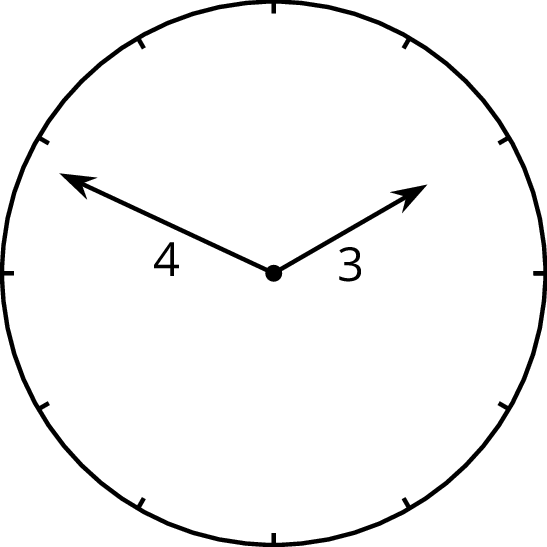Lesson 9
The Converse
Let’s figure out if a triangle is a right triangle.
9.1: The Hands of a Clock
Consider the tips of the hands of an analog clock that has an hour hand that is 3 centimeters long and a minute hand that is 4 centimeters long.

Over the course of a day:
-
What is the farthest apart the two tips get?
-
What is the closest the two tips get?
-
Are the two tips ever exactly five centimeters apart?
9.2: Proving the Converse
Here are three triangles with two side lengths measuring 3 and 4 units, and the third side of unknown length.

Sort the following six numbers from smallest to largest. Put an equal sign between any you know to be equal. Be ready to explain your reasoning.
\(\displaystyle 1\qquad 5\qquad 7\qquad x\qquad y\qquad z \)
A related argument also lets us distinguish acute from obtuse triangles using only their side lengths.
Decide if triangles with the following side lengths are acute, right, or obtuse. In right or obtuse triangles, identify which side length is opposite the right or obtuse angle.
- \(x=15\), \(y=20\), \(z=8\)
- \(x=8\), \(y=15\), \(z=13\)
-
\(x=17\), \(y=8\), \(z=15\)
9.3: Calculating Legs of Right Triangles
- Given the information provided for the right triangles shown here, find the unknown leg lengths to the nearest tenth.

- The triangle shown here is not a right triangle. What are two different ways you change one of the values so it would be a right triangle? Sketch these new right triangles, and clearly label the right angle.

Summary
What if it isn’t clear whether a triangle is a right triangle or not? Here is a triangle:

Is it a right triangle? It’s hard to tell just by looking, and it may be that the sides aren’t drawn to scale.
If we have a triangle with side lengths \(a\), \(b\), and \(c\), with \(c\) being the longest of the three, then the converse of the Pythagorean Theorem tells us that any time we have \(a^2+b^2=c^2\), we must have a right triangle. Since \(8^2+15^2=64+225=289=17^2\), any triangle with side lengths 8, 15, and 17 must be a right triangle.
Together, the Pythagorean Theorem and its converse provide a one-step test for checking to see if a triangle is a right triangle just using its side lengths. If \(a^2+b^2=c^2\), it is a right triangle. If \(a^2+b^2\neq c^2\), it is not a right triangle.
Glossary Entries
- Pythagorean Theorem
The Pythagorean Theorem describes the relationship between the side lengths of right triangles.
The diagram shows a right triangle with squares built on each side. If we add the areas of the two small squares, we get the area of the larger square.
The square of the hypotenuse is equal to the sum of the squares of the legs. This is written as \(a^2+b^2=c^2\).

- hypotenuse
The hypotenuse is the side of a right triangle that is opposite the right angle. It is the longest side of a right triangle.
Here are some right triangles. Each hypotenuse is labeled.

- legs
The legs of a right triangle are the sides that make the right angle.
Here are some right triangles. Each leg is labeled.
